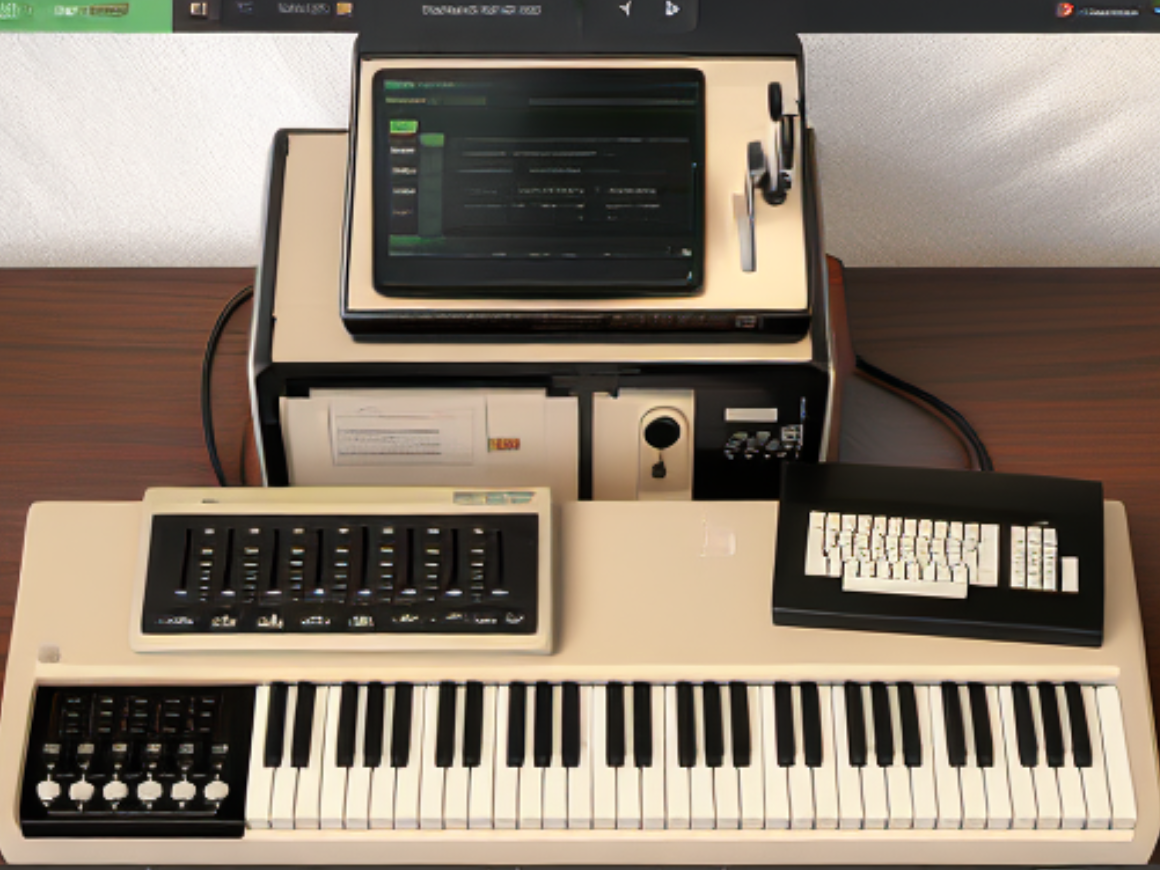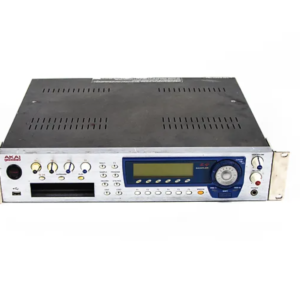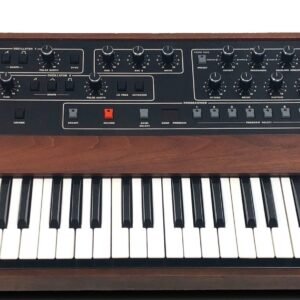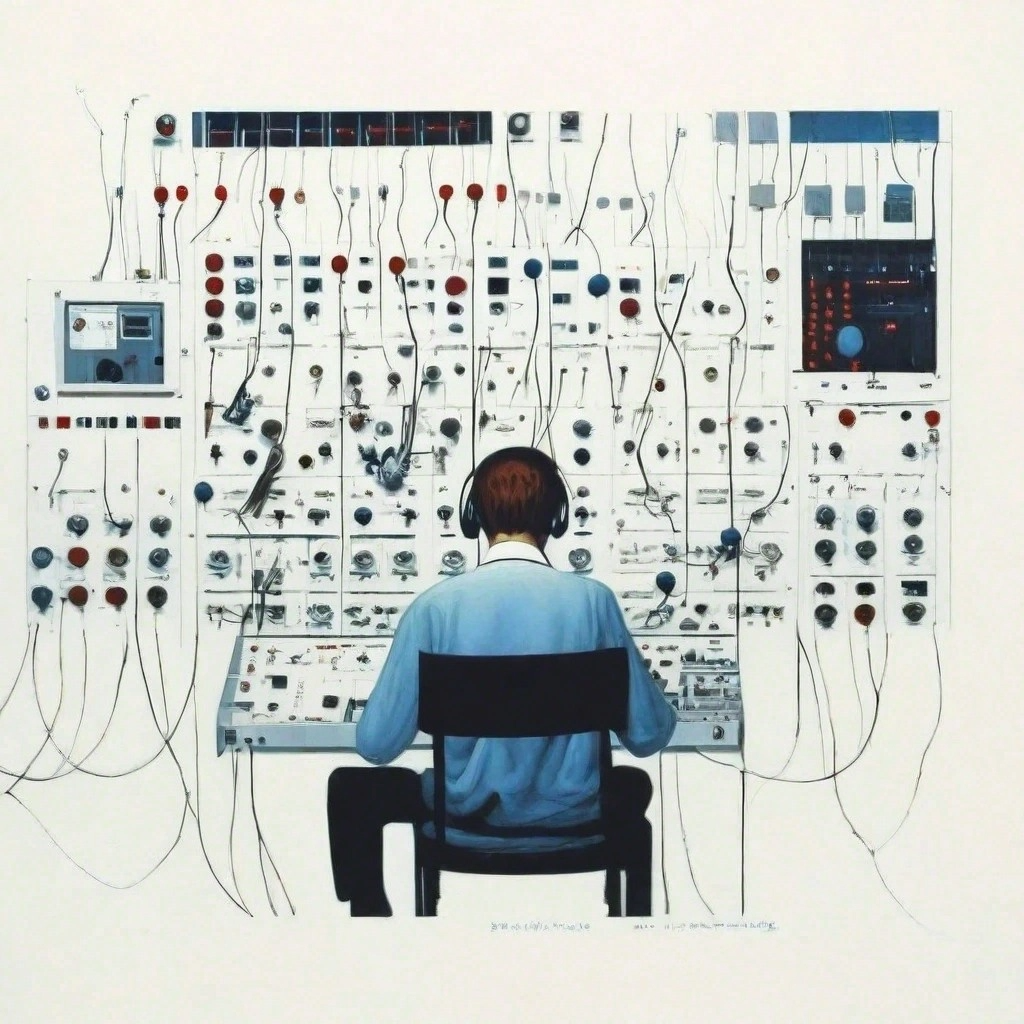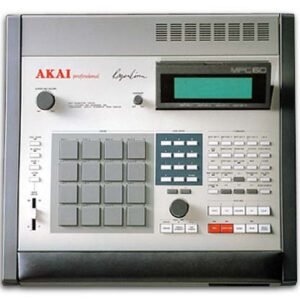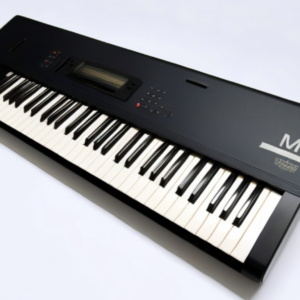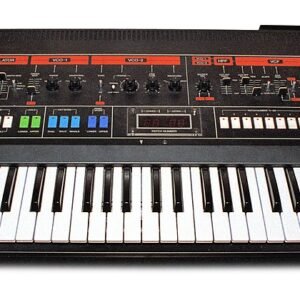Introduction
The Fairlight CMI, short for Fairlight Computer Musical Instrument, stands as an iconic milestone in the history of electronic music production. Developed by Peter Vogel and Kim Ryrie, the Fairlight CMI emerged in the late 1970s, revolutionizing the way music was composed, produced, and performed. With its pioneering digital sampling technology and innovative user interface, the Fairlight CMI played a pivotal role in shaping the sound of popular music throughout the 1980s and beyond.
At its core, the Fairlight CMI represented a fusion of cutting-edge computer technology and musical creativity. It introduced musicians to the concept of sampling, allowing them to capture and manipulate sounds from the real world with unprecedented ease and flexibility. This breakthrough opened up endless possibilities for sonic experimentation, enabling artists to explore new sonic landscapes and redefine the boundaries of music production.
Beyond its technical capabilities, the Fairlight CMI became a symbol of status and sophistication within the music industry. Its distinctive design, featuring a sleek black chassis adorned with colorful graphics and an array of buttons and sliders, made a bold statement in any studio environment. Musicians, producers, and composers were drawn to the Fairlight CMI not only for its groundbreaking features but also for its aura of innovation and prestige.
As we delve deeper into the legacy of the Fairlight CMI, we will explore its design and features, its impact on sound generation, its notable users and influences, its enduring legacy in the music industry, and its ongoing relevance in the world of electronic music production. Join us on a journey through the history and innovation of one of the most iconic synthesizers and samplers ever created.
Design and Features
The design of the Fairlight CMI was ahead of its time, both in terms of its physical appearance and its groundbreaking features. Here, we delve into the design elements and innovative features that set the Fairlight CMI apart from its contemporaries.
**1. Physical Design:**
The Fairlight CMI featured a distinctive and futuristic design that captured the imagination of musicians and producers alike. Housed in a sleek black chassis, the Fairlight CMI exuded an air of sophistication and cutting-edge technology. Its compact form factor made it suitable for both studio and live performance settings, while its rugged construction ensured durability and reliability.
**2. User Interface:**
One of the most revolutionary aspects of the Fairlight CMI was its user interface, which provided intuitive control over its powerful features. The centerpiece of the interface was the light pen, a stylus-like device that allowed users to interact with the Fairlight’s graphical interface directly on the built-in monitor. This innovative approach to user interaction simplified the process of sample editing, sequencing, and sound design, making it accessible to musicians of all skill levels.
**3. Sampling Capabilities:**
At the heart of the Fairlight CMI was its pioneering sampling technology, which allowed users to record and manipulate sounds with unprecedented precision. The Fairlight CMI offered sampling rates of up to 24 kHz, providing high-fidelity reproduction of recorded sounds. Its generous sample memory capacity allowed users to store and manipulate large libraries of sounds, opening up endless possibilities for creative expression.
**4. Synthesis Capabilities:**
In addition to its sampling capabilities, the Fairlight CMI also featured powerful synthesis capabilities, including additive synthesis, subtractive synthesis, and FM synthesis. This versatility allowed users to create a wide range of sounds, from realistic instrument emulations to otherworldly sonic textures. With its flexible synthesis engine, the Fairlight CMI became a staple in the production of electronic music, shaping the sound of countless hit records.
**5. Sequencing and Arranging:**
The Fairlight CMI offered comprehensive sequencing and arranging features, allowing users to compose complex musical arrangements with ease. Its built-in sequencer provided intuitive control over note placement, tempo, and dynamics, while its sophisticated arrangement tools allowed for seamless integration of sampled sounds and synthesized elements. This combination of sampling, synthesis, and sequencing capabilities made the Fairlight CMI a complete music production workstation.
**6. Connectivity:**
To accommodate a wide range of studio setups, the Fairlight CMI offered extensive connectivity options, including MIDI, analog audio I/O, and digital interfaces. This allowed users to integrate the Fairlight CMI seamlessly into their existing studio setups, connecting it to external instruments, effects processors, and recording equipment.
In summary, the design and features of the Fairlight CMI set a new standard for electronic music production, combining innovative technology with intuitive user interface design. Its pioneering sampling and synthesis capabilities, coupled with its comprehensive sequencing and arranging features, made it an indispensable tool for musicians, producers, and composers around the world.
Sound Generation
The Fairlight CMI (Computer Musical Instrument) revolutionized sound generation with its pioneering digital sampling technology and versatile synthesis capabilities. In this section, we delve into the methods by which the Fairlight CMI produced its distinctive sounds and explore the impact of its sound generation capabilities on music production.
**1. Sampling Technology:**
At the core of the Fairlight CMI’s sound generation capabilities was its innovative sampling technology. Unlike traditional synthesizers that generated sounds using oscillators and filters, the Fairlight CMI allowed users to record and manipulate real-world sounds, known as samples. These samples could be anything from musical instruments and vocals to environmental sounds and special effects.
The Fairlight CMI offered unprecedented flexibility in sample manipulation, allowing users to modify pitch, duration, and timbre with ease. By combining and layering samples, users could create rich, complex sounds that were impossible to achieve with traditional synthesis methods. This ability to capture and manipulate real-world sounds revolutionized music production, opening up new creative possibilities for musicians and producers.
**2. Synthesis Capabilities:**
In addition to its sampling technology, the Fairlight CMI boasted powerful synthesis capabilities that further expanded its sonic palette. The instrument offered a range of synthesis methods, including additive synthesis, subtractive synthesis, and frequency modulation (FM) synthesis. This versatility allowed users to create a wide variety of sounds, from realistic instrument emulations to futuristic, otherworldly textures.
Additive synthesis, in particular, allowed users to construct sounds from individual harmonics, giving them precise control over the timbre and harmonic content of their sounds. Subtractive synthesis, on the other hand, allowed users to sculpt sounds by filtering out unwanted frequencies, while FM synthesis offered complex, evolving textures by modulating the frequency of one waveform with another.
By combining sampling with synthesis, the Fairlight CMI offered a hybrid approach to sound generation that was unparalleled at the time. Musicians and producers could seamlessly blend sampled sounds with synthesized elements, blurring the lines between acoustic and electronic instrumentation. This hybrid approach played a crucial role in shaping the sound of popular music throughout the 1980s and beyond.
**3. Sound Design and Manipulation:**
The Fairlight CMI provided powerful tools for sound design and manipulation, allowing users to sculpt and shape sounds to their exact specifications. Its intuitive user interface made it easy to edit and modify samples, with features such as looping, crossfading, and time-stretching enabling precise control over sound playback. Users could also apply a variety of effects, such as reverb, delay, and chorus, to further enhance their sounds.
Furthermore, the Fairlight CMI offered sophisticated modulation capabilities, allowing users to dynamically control parameters such as pitch, amplitude, and timbre over time. This added a level of expressiveness and realism to the instrument’s sounds, allowing for dynamic, evolving textures that responded to the nuances of the performer’s playing.
In summary, the Fairlight CMI’s sound generation capabilities represented a paradigm shift in music production, offering unprecedented flexibility and control over sound creation. Its combination of sampling and synthesis technology, coupled with powerful sound design tools, empowered musicians and producers to explore new sonic territories and redefine the boundaries of music composition and performance.
Technical Specifications
The technical specifications of the Fairlight CMI (Computer Musical Instrument) reflect its pioneering status in the realm of electronic music production. Here, we outline the key specifications that defined the capabilities of this iconic instrument.
**1. Sampling:**
– Sampling Rate: Up to 24 kHz
– Bit Depth: 8-bit
– Sample Memory: Varied across different models, typically ranging from 256 KB to 1 MB
– Sampling Input: Mono or Stereo
**2. Synthesis:**
– Synthesis Methods: Additive synthesis, Subtractive synthesis, Frequency Modulation (FM) synthesis
– Oscillators: Variable, depending on synthesis method
– Filters: Variable, depending on synthesis method
– Envelopes: ADSR (Attack, Decay, Sustain, Release) envelopes for amplitude and filter modulation
**3. Polyphony:**
– Polyphony: Varied across different models, typically ranging from 8 to 16 voices
– Voice Allocation: Dynamic voice allocation for efficient use of polyphony
**4. User Interface:**
– Display: Built-in CRT monitor for graphical interface
– Input Devices: Light pen for direct interaction with the graphical interface
– Controls: Array of buttons, sliders, and knobs for parameter adjustment
**5. Sequencing and Arranging:**
– Sequencer: Built-in sequencer with multiple tracks and pattern-based arrangement
– Tempo: Adjustable tempo control with synchronization capabilities
– MIDI: MIDI connectivity for external control and synchronization with other MIDI-compatible devices
**6. Effects:**
– Built-in Effects: Reverb, Delay, Chorus, Flanger, Phaser, EQ
– Effects Parameters: Adjustable parameters for fine-tuning effect settings
**7. Connectivity:**
– Analog Audio I/O: Balanced XLR and 1/4″ TRS connections for audio input and output
– Digital I/O: Optional digital interfaces for AES/EBU or SPDIF connectivity
– MIDI I/O: MIDI input, output, and thru ports for MIDI communication
**8. Storage:**
– Internal Storage: Varied across different models, typically featuring built-in floppy disk drives for sample and sequence storage
– External Storage: Optional external storage devices for expanded storage capacity
**9. Power:**
– Power Supply: Internal power supply unit compatible with standard AC power sources
– Voltage: Available in both 110V and 220V configurations
**10. Dimensions and Weight:**
– Dimensions: Varied across different models, typically compact and portable
– Weight: Varied across different models, typically ranging from 20 to 50 kilograms
In summary, the Fairlight CMI boasted cutting-edge technical specifications that set it apart as a groundbreaking instrument in the world of electronic music production. Its combination of advanced sampling and synthesis capabilities, intuitive user interface, and comprehensive sequencing and arranging features made it a favorite among musicians, producers, and composers worldwide.
Performance and Workflow
The Fairlight CMI (Computer Musical Instrument) was not only renowned for its groundbreaking technical specifications but also for its exceptional performance capabilities and streamlined workflow. In this section, we explore how the Fairlight CMI facilitated efficient music production processes and empowered musicians to realize their creative visions with ease.
**1. Real-Time Performance:**
– The Fairlight CMI offered real-time performance capabilities, allowing musicians to interact with sounds and sequences dynamically. Its intuitive user interface, featuring a light pen and graphical display, enabled performers to make instant adjustments to parameters such as pitch, duration, and timbre.
**2. Sampling and Sound Design:**
– The Fairlight CMI revolutionized the process of sampling and sound design, offering powerful tools for capturing, editing, and manipulating sounds. Musicians could record sounds from the real world and instantly transform them into musical instruments using the instrument’s intuitive sampling interface. With features such as looping, crossfading, and time-stretching, users could sculpt and shape sounds to their exact specifications.
**3. Sequencing and Arranging:**
– The Fairlight CMI featured a built-in sequencer with comprehensive sequencing and arranging capabilities. Musicians could create complex musical arrangements with multiple tracks, patterns, and sections, all within a single interface. The instrument’s pattern-based approach to sequencing allowed for flexible arrangement of musical elements, while its tempo control and synchronization capabilities ensured tight integration with external devices.
**4. Integration with External Devices:**
– The Fairlight CMI seamlessly integrated with external devices such as MIDI keyboards, drum machines, and effects processors, expanding its sonic capabilities and enhancing workflow efficiency. Musicians could control and synchronize external devices directly from the Fairlight’s interface, streamlining the process of creating and manipulating music.
**5. Performance Tools:**
– The Fairlight CMI provided a range of performance tools to enhance the live performance experience. Users could assign sounds and sequences to individual keys or pads, allowing for dynamic triggering and manipulation of musical elements. Additionally, the instrument offered real-time effects processing, enabling performers to add depth and texture to their sounds on the fly.
**6. Workflow Optimization:**
– The Fairlight CMI was designed with workflow optimization in mind, featuring a streamlined user interface and efficient navigation tools. Musicians could access all essential functions and parameters with minimal effort, allowing for seamless transition between different stages of the music production process. This optimization of workflow ensured that users could focus on their creative vision without being hindered by technical constraints.
In summary, the Fairlight CMI offered exceptional performance capabilities and a streamlined workflow that empowered musicians to express their creativity with unparalleled freedom and flexibility. Its intuitive interface, comprehensive sequencing and arranging features, and seamless integration with external devices made it a staple in the studios of musicians, producers, and composers around the world.
**Notable Users and Influences**
The Fairlight CMI (Computer Musical Instrument) has left an indelible mark on the world of music, influencing countless artists, producers, and composers across various genres. In this section, we explore some of the notable users who embraced the Fairlight CMI and the profound impact it had on their music and the wider music industry.
**1. Peter Gabriel:**
– One of the earliest and most prominent adopters of the Fairlight CMI, Peter Gabriel utilized the instrument extensively on his groundbreaking album “Security” (1982). The distinctive sound of the Fairlight can be heard throughout the album, particularly on tracks like “Shock the Monkey” and “San Jacinto,” where Gabriel employed the instrument to create innovative sonic textures and atmospheric soundscapes.
**2. Kate Bush:**
– Renowned for her adventurous approach to music production, Kate Bush incorporated the Fairlight CMI into her seminal album “Hounds of Love” (1985). The instrument played a central role in shaping the album’s lush and ethereal sound, with Bush using it to orchestrate intricate arrangements and add layers of rich, synthesized textures to her compositions.
**3. Jean-Michel Jarre:**
– As a pioneer of electronic music, Jean-Michel Jarre embraced the Fairlight CMI as a key component of his sonic palette. The instrument featured prominently on albums such as “Zoolook” (1984), where Jarre used its sampling and synthesis capabilities to create futuristic soundscapes and blend elements of world music with electronic rhythms.
**4. Trevor Horn (The Art of Noise):**
– Trevor Horn, along with his group The Art of Noise, played a significant role in popularizing the Fairlight CMI in the realm of pop music. The group’s innovative use of sampling and electronic manipulation on tracks like “Close (to the Edit)” showcased the creative potential of the instrument and helped shape the sound of 1980s pop.
**5. Herbie Hancock:**
– Jazz-fusion pioneer Herbie Hancock embraced the Fairlight CMI on his album “Future Shock” (1983), incorporating its cutting-edge technology into his distinctive blend of jazz, funk, and electronic music. Tracks like “Rockit” featured the Fairlight’s signature sound prominently, demonstrating Hancock’s willingness to embrace new technologies and push the boundaries of musical experimentation.
**6. Hans Zimmer:**
– Acclaimed film composer Hans Zimmer is known for his innovative approach to film scoring, and the Fairlight CMI has been a key tool in his sonic arsenal. Zimmer used the instrument extensively on scores for films such as “Rain Man” (1988) and “The Dark Knight” (2008), leveraging its sampling and synthesis capabilities to create immersive soundtracks that enhance the emotional impact of the films.
**7. Influence on Music Production:**
– Beyond its impact on individual artists, the Fairlight CMI played a pivotal role in shaping the landscape of music production in the 1980s and beyond. Its innovative sampling and synthesis technology paved the way for a new era of electronic music, influencing genres ranging from pop and rock to hip-hop and dance music. The Fairlight CMI’s legacy lives on in modern music production tools, with its pioneering spirit continuing to inspire musicians and producers to push the boundaries of creativity and innovation.
In summary, the Fairlight CMI’s influence on music and music production is undeniable, with its distinctive sound shaping the work of iconic artists and its innovative technology revolutionizing the way music is composed, produced, and experienced. From Peter Gabriel to Hans Zimmer, the Fairlight CMI has left an enduring legacy that continues to resonate in the world of music today.
Notable Users and Influences
The Fairlight CMI (Computer Musical Instrument) has left an indelible mark on the world of music, influencing countless artists, producers, and composers across various genres. In this section, we explore some of the notable users who embraced the Fairlight CMI and the profound impact it had on their music and the wider music industry.
**1. Peter Gabriel:**
– One of the earliest and most prominent adopters of the Fairlight CMI, Peter Gabriel utilized the instrument extensively on his groundbreaking album “Security” (1982). The distinctive sound of the Fairlight can be heard throughout the album, particularly on tracks like “Shock the Monkey” and “San Jacinto,” where Gabriel employed the instrument to create innovative sonic textures and atmospheric soundscapes.
**2. Kate Bush:**
– Renowned for her adventurous approach to music production, Kate Bush incorporated the Fairlight CMI into her seminal album “Hounds of Love” (1985). The instrument played a central role in shaping the album’s lush and ethereal sound, with Bush using it to orchestrate intricate arrangements and add layers of rich, synthesized textures to her compositions.
**3. Jean-Michel Jarre:**
– As a pioneer of electronic music, Jean-Michel Jarre embraced the Fairlight CMI as a key component of his sonic palette. The instrument featured prominently on albums such as “Zoolook” (1984), where Jarre used its sampling and synthesis capabilities to create futuristic soundscapes and blend elements of world music with electronic rhythms.
**4. Trevor Horn (The Art of Noise):**
– Trevor Horn, along with his group The Art of Noise, played a significant role in popularizing the Fairlight CMI in the realm of pop music. The group’s innovative use of sampling and electronic manipulation on tracks like “Close (to the Edit)” showcased the creative potential of the instrument and helped shape the sound of 1980s pop.
**5. Herbie Hancock:**
– Jazz-fusion pioneer Herbie Hancock embraced the Fairlight CMI on his album “Future Shock” (1983), incorporating its cutting-edge technology into his distinctive blend of jazz, funk, and electronic music. Tracks like “Rockit” featured the Fairlight’s signature sound prominently, demonstrating Hancock’s willingness to embrace new technologies and push the boundaries of musical experimentation.
**6. Hans Zimmer:**
– Acclaimed film composer Hans Zimmer is known for his innovative approach to film scoring, and the Fairlight CMI has been a key tool in his sonic arsenal. Zimmer used the instrument extensively on scores for films such as “Rain Man” (1988) and “The Dark Knight” (2008), leveraging its sampling and synthesis capabilities to create immersive soundtracks that enhance the emotional impact of the films.
**7. Influence on Music Production:**
– Beyond its impact on individual artists, the Fairlight CMI played a pivotal role in shaping the landscape of music production in the 1980s and beyond. Its innovative sampling and synthesis technology paved the way for a new era of electronic music, influencing genres ranging from pop and rock to hip-hop and dance music. The Fairlight CMI’s legacy lives on in modern music production tools, with its pioneering spirit continuing to inspire musicians and producers to push the boundaries of creativity and innovation.
In summary, the Fairlight CMI’s influence on music and music production is undeniable, with its distinctive sound shaping the work of iconic artists and its innovative technology revolutionizing the way music is composed, produced, and experienced. From Peter Gabriel to Hans Zimmer, the Fairlight CMI has left an enduring legacy that continues to resonate in the world of music today.
Impact and Legacy
The Fairlight CMI (Computer Musical Instrument) stands as a monumental innovation in the history of music technology, leaving an indelible impact on the world of music production and shaping the trajectory of electronic music. In this section, we explore the profound impact and enduring legacy of the Fairlight CMI.
**1. Revolutionary Technology:**
– The Fairlight CMI introduced revolutionary technology to the world of music production, pioneering the use of digital sampling and synthesis. Its groundbreaking capabilities allowed musicians to sample and manipulate real-world sounds with unprecedented precision, opening up new creative possibilities and pushing the boundaries of sonic experimentation.
**2. Redefining Music Production:**
– The Fairlight CMI revolutionized the way music was composed, produced, and performed, democratizing the process of music production and empowering artists to explore new sonic territories. Its intuitive user interface and powerful features made it accessible to musicians of all backgrounds, democratizing access to professional-quality music production tools.
**3. Shaping Popular Music:**
– The Fairlight CMI played a pivotal role in shaping the sound of popular music throughout the 1980s and beyond. Its distinctive sound can be heard on countless hit records across a variety of genres, from pop and rock to hip-hop and electronic dance music. Artists embraced the Fairlight CMI for its ability to create rich, textured sounds and its capacity to inspire innovation and experimentation.
**4. Cultural Icon:**
– Beyond its technical capabilities, the Fairlight CMI became a cultural icon, symbolizing the cutting edge of music technology and sophistication within the music industry. Its sleek design and futuristic aesthetic made it a coveted instrument among musicians, producers, and composers, cementing its status as a symbol of creativity and innovation.
**5. Influence on Future Technology:**
– The Fairlight CMI’s influence extends far beyond its own era, shaping the development of future music technology and production tools. Its pioneering approach to sampling and synthesis laid the groundwork for modern digital audio workstations (DAWs) and software synthesizers, influencing the design and functionality of countless software instruments and plugins.
**6. Enduring Inspiration:**
– The legacy of the Fairlight CMI continues to inspire musicians, producers, and composers to push the boundaries of creativity and innovation in music production. Its iconic sound and innovative features serve as a reminder of the transformative power of technology in shaping the evolution of music, inspiring new generations of artists to explore new sonic possibilities and redefine the future of music.
In summary, the Fairlight CMI’s impact and legacy are immeasurable, leaving an indelible mark on the world of music production and shaping the course of electronic music history. Its revolutionary technology, cultural significance, and enduring inspiration continue to resonate with musicians and music enthusiasts around the world, ensuring its place as one of the most iconic and influential instruments in the annals of music technology.
Collector's Value and Market Trends
The Fairlight CMI (Computer Musical Instrument) holds a special place in the hearts of musicians, producers, and collectors alike, with its iconic status and groundbreaking technology contributing to its significant collector’s value. In this section, we delve into the collector’s value and market trends surrounding the Fairlight CMI.
**1. Rarity and Historical Significance:**
– The Fairlight CMI is revered for its rarity and historical significance in the realm of music technology. As one of the first digital sampling instruments, it represents a pivotal moment in the evolution of music production, making it highly sought after by collectors and enthusiasts.
**2. Iconic Status:**
– The Fairlight CMI’s iconic status within the music industry further enhances its collector’s value. Its distinctive design, pioneering technology, and association with influential artists contribute to its allure among collectors, who seek to own a piece of music history.
**3. Limited Availability:**
– The Fairlight CMI is no longer in production, with only a limited number of units produced during its manufacturing run. This scarcity adds to its collector’s value, as collectors compete to acquire one of the few remaining examples of this iconic instrument.
**4. Demand from Musicians and Producers:**
– Despite its age, the Fairlight CMI continues to be in demand among musicians and producers who value its unique sound and historical significance. This demand from users seeking to incorporate vintage gear into their setups further drives up the collector’s value of the instrument.
**5. Market Trends:**
– In recent years, there has been a growing interest in vintage synthesizers and samplers, driven by nostalgia and a renewed appreciation for analog and early digital technology. This trend has led to an increase in prices for vintage instruments like the Fairlight CMI, as collectors and enthusiasts compete for limited supply in the market.
**6. Investment Potential:**
– The Fairlight CMI holds significant investment potential for collectors who are able to acquire one in good condition. As demand for vintage music technology continues to grow, the value of the Fairlight CMI is likely to appreciate over time, making it not only a prized possession but also a sound investment.
**7. Preservation Efforts:**
– Efforts to preserve and restore vintage Fairlight CMIs have contributed to their collector’s value, as collectors and enthusiasts recognize the importance of maintaining these iconic instruments for future generations. Restoration projects and upgrades can further enhance the value of a Fairlight CMI, as collectors seek instruments that are in optimal working condition.
In summary, the Fairlight CMI’s collector’s value is driven by its rarity, historical significance, and iconic status within the music industry. As demand for vintage music technology continues to grow, the value of the Fairlight CMI is expected to appreciate, making it a prized possession for collectors and enthusiasts who appreciate its unique sound and contribution to music history.
Innovations and Contributions
The Fairlight CMI (Computer Musical Instrument) stands as a beacon of innovation in the realm of music technology, introducing revolutionary concepts and pushing the boundaries of what was thought possible in music production. In this section, we explore the innovations and contributions of the Fairlight CMI that have shaped the landscape of modern music.
**1. Digital Sampling:**
– Perhaps the most significant innovation of the Fairlight CMI was its introduction of digital sampling technology to the world of music production. The ability to capture and manipulate real-world sounds with precision opened up new creative possibilities for musicians, allowing for the creation of realistic instrument emulations, vocal samples, and environmental textures.
**2. Sampling Interface:**
– The Fairlight CMI’s intuitive sampling interface, featuring a light pen and graphical display, revolutionized the process of sample editing and manipulation. Musicians could interact directly with the waveform on the screen, making precise adjustments to parameters such as pitch, duration, and amplitude with ease.
**3. Hybrid Synthesis:**
– The Fairlight CMI pioneered the concept of hybrid synthesis, combining digital sampling with traditional synthesis methods such as additive synthesis, subtractive synthesis, and frequency modulation (FM) synthesis. This hybrid approach allowed for the creation of complex, layered sounds that blurred the lines between acoustic and electronic instrumentation.
**4. Integrated Workstation:**
– The Fairlight CMI served as a complete music production workstation, integrating sampling, synthesis, sequencing, and arranging capabilities into a single instrument. This holistic approach to music production streamlined workflow and empowered musicians to compose, produce, and perform music with unprecedented efficiency and creativity.
**5. User Interface Design:**
– The Fairlight CMI’s user interface design set a new standard for intuitive interaction with music technology. Its graphical display and light pen interface provided a visual representation of sound, making complex processes such as sample editing and waveform manipulation accessible to musicians of all skill levels.
**6. Influence on Future Technology:**
– The innovations introduced by the Fairlight CMI had a profound influence on the development of future music technology. Its pioneering approach to digital sampling and synthesis laid the groundwork for modern digital audio workstations (DAWs), software synthesizers, and sampling instruments, shaping the trajectory of music production for decades to come.
**7. Cultural Impact:**
– Beyond its technical innovations, the Fairlight CMI had a significant cultural impact, shaping the sound of popular music and influencing the creative vision of generations of musicians, producers, and composers. Its distinctive sound can be heard on countless hit records across a variety of genres, cementing its status as a cultural icon in the world of music.
In summary, the Fairlight CMI’s innovations and contributions have left an indelible mark on the landscape of music technology and production. From its pioneering use of digital sampling to its intuitive user interface design, the Fairlight CMI continues to inspire creativity and innovation in music production, serving as a timeless testament to the power of technology to shape the future of music.
